MGMT20132 - P&G Case Study: Analyzing Disruptive Business Models
VerifiedAdded on 2023/06/12
|9
|2034
|367
Essay
AI Summary
This essay provides an in-depth analysis of Procter & Gamble's (P&G) business models, focusing on the impact of disruptive innovation and smart products. It explores the opportunities and threats P&G faces in the global market, particularly concerning competition and evolving consumer demands. The analysis utilizes the Osterwalder & Pigneur Business Model Framework to illustrate P&G's key partners, activities, value propositions, customer relationships, channels, resources, cost structure, and revenue streams. The essay highlights P&G's strategies for adapting to changing market conditions, leveraging technology, and maintaining a competitive edge through continuous disruption and innovation. The conclusion emphasizes the importance of disruptive business models for firms like P&G to remain competitive and meet evolving customer needs.
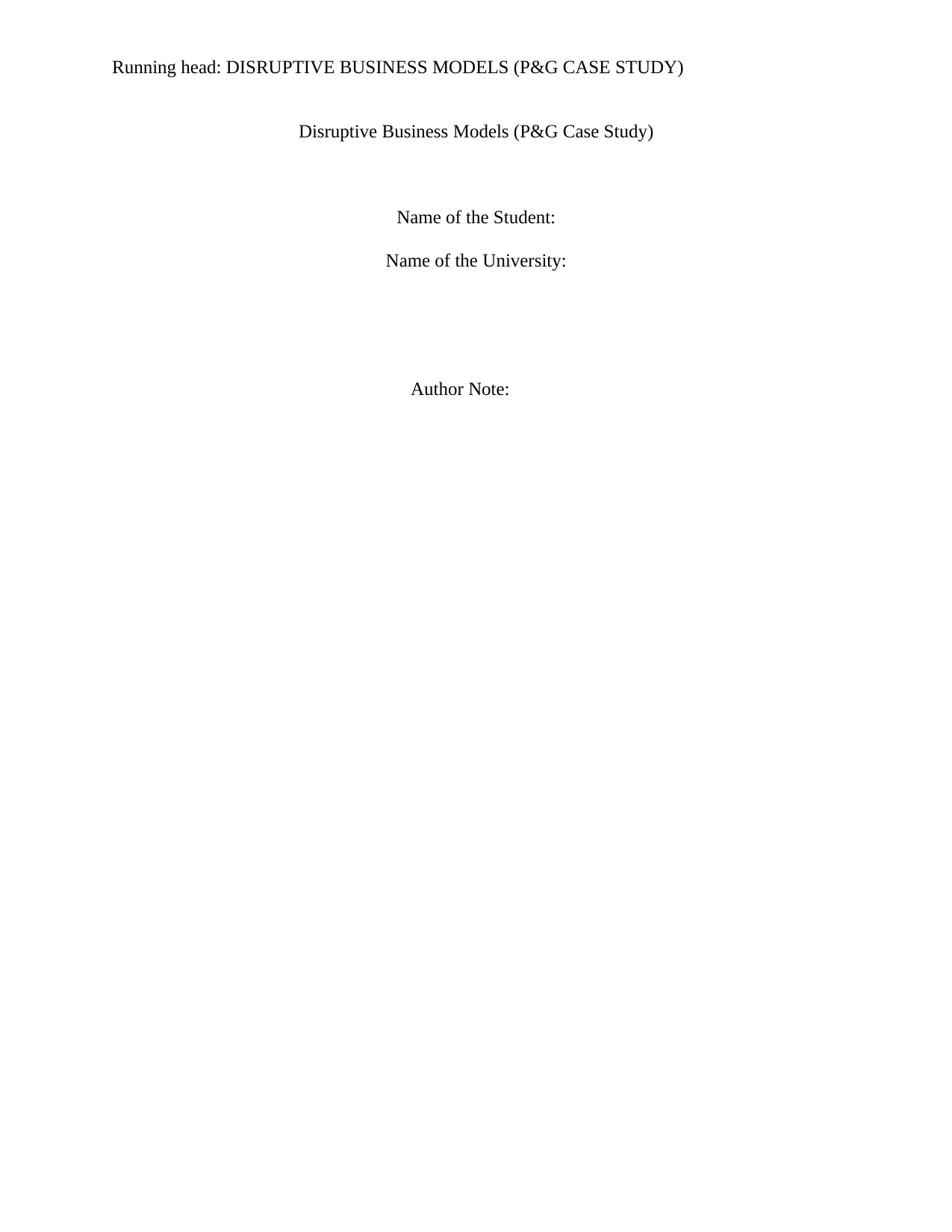
Running head: DISRUPTIVE BUSINESS MODELS (P&G CASE STUDY)
Disruptive Business Models (P&G Case Study)
Name of the Student:
Name of the University:
Author Note:
Disruptive Business Models (P&G Case Study)
Name of the Student:
Name of the University:
Author Note:
Paraphrase This Document
Need a fresh take? Get an instant paraphrase of this document with our AI Paraphraser
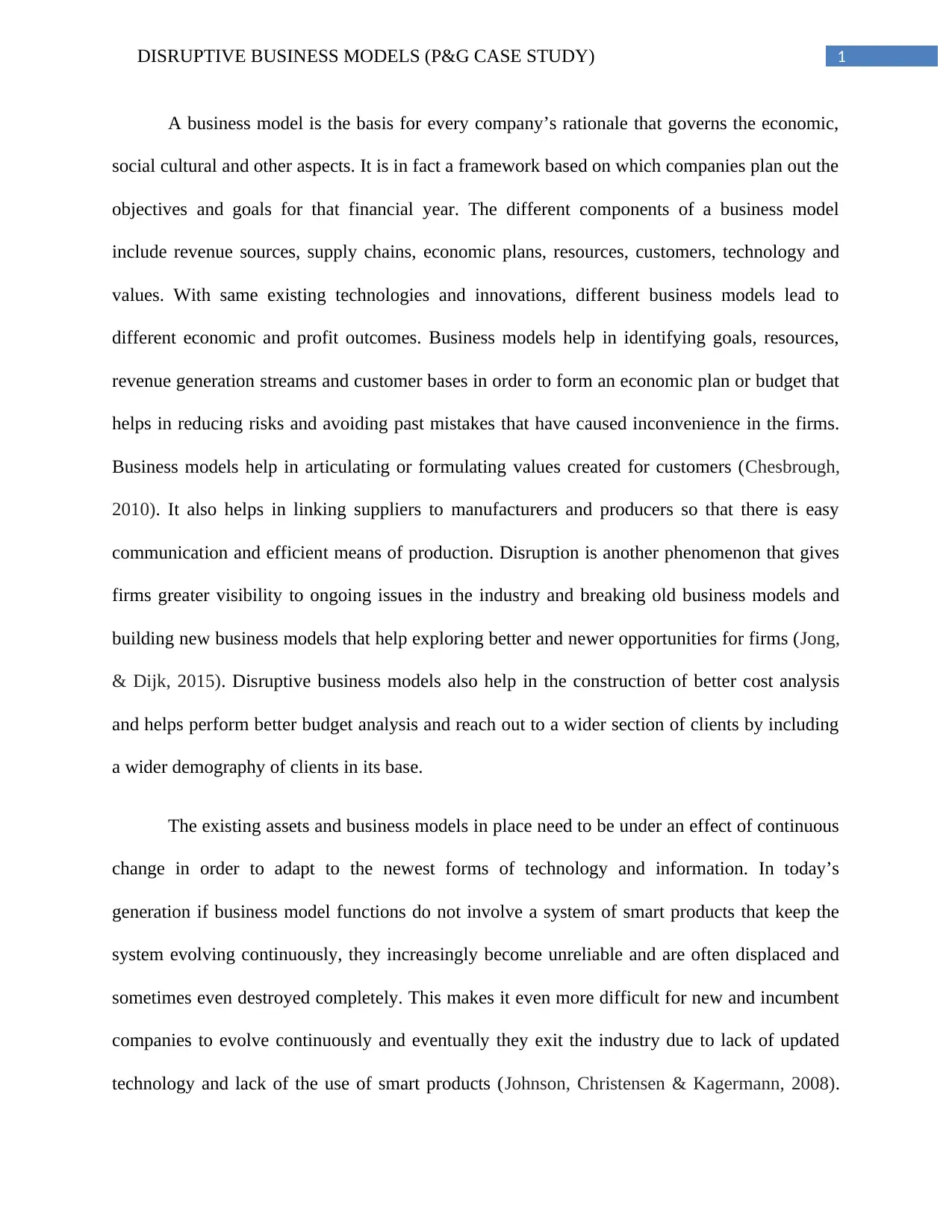
1DISRUPTIVE BUSINESS MODELS (P&G CASE STUDY)
A business model is the basis for every company’s rationale that governs the economic,
social cultural and other aspects. It is in fact a framework based on which companies plan out the
objectives and goals for that financial year. The different components of a business model
include revenue sources, supply chains, economic plans, resources, customers, technology and
values. With same existing technologies and innovations, different business models lead to
different economic and profit outcomes. Business models help in identifying goals, resources,
revenue generation streams and customer bases in order to form an economic plan or budget that
helps in reducing risks and avoiding past mistakes that have caused inconvenience in the firms.
Business models help in articulating or formulating values created for customers (Chesbrough,
2010). It also helps in linking suppliers to manufacturers and producers so that there is easy
communication and efficient means of production. Disruption is another phenomenon that gives
firms greater visibility to ongoing issues in the industry and breaking old business models and
building new business models that help exploring better and newer opportunities for firms (Jong,
& Dijk, 2015). Disruptive business models also help in the construction of better cost analysis
and helps perform better budget analysis and reach out to a wider section of clients by including
a wider demography of clients in its base.
The existing assets and business models in place need to be under an effect of continuous
change in order to adapt to the newest forms of technology and information. In today’s
generation if business model functions do not involve a system of smart products that keep the
system evolving continuously, they increasingly become unreliable and are often displaced and
sometimes even destroyed completely. This makes it even more difficult for new and incumbent
companies to evolve continuously and eventually they exit the industry due to lack of updated
technology and lack of the use of smart products (Johnson, Christensen & Kagermann, 2008).
A business model is the basis for every company’s rationale that governs the economic,
social cultural and other aspects. It is in fact a framework based on which companies plan out the
objectives and goals for that financial year. The different components of a business model
include revenue sources, supply chains, economic plans, resources, customers, technology and
values. With same existing technologies and innovations, different business models lead to
different economic and profit outcomes. Business models help in identifying goals, resources,
revenue generation streams and customer bases in order to form an economic plan or budget that
helps in reducing risks and avoiding past mistakes that have caused inconvenience in the firms.
Business models help in articulating or formulating values created for customers (Chesbrough,
2010). It also helps in linking suppliers to manufacturers and producers so that there is easy
communication and efficient means of production. Disruption is another phenomenon that gives
firms greater visibility to ongoing issues in the industry and breaking old business models and
building new business models that help exploring better and newer opportunities for firms (Jong,
& Dijk, 2015). Disruptive business models also help in the construction of better cost analysis
and helps perform better budget analysis and reach out to a wider section of clients by including
a wider demography of clients in its base.
The existing assets and business models in place need to be under an effect of continuous
change in order to adapt to the newest forms of technology and information. In today’s
generation if business model functions do not involve a system of smart products that keep the
system evolving continuously, they increasingly become unreliable and are often displaced and
sometimes even destroyed completely. This makes it even more difficult for new and incumbent
companies to evolve continuously and eventually they exit the industry due to lack of updated
technology and lack of the use of smart products (Johnson, Christensen & Kagermann, 2008).
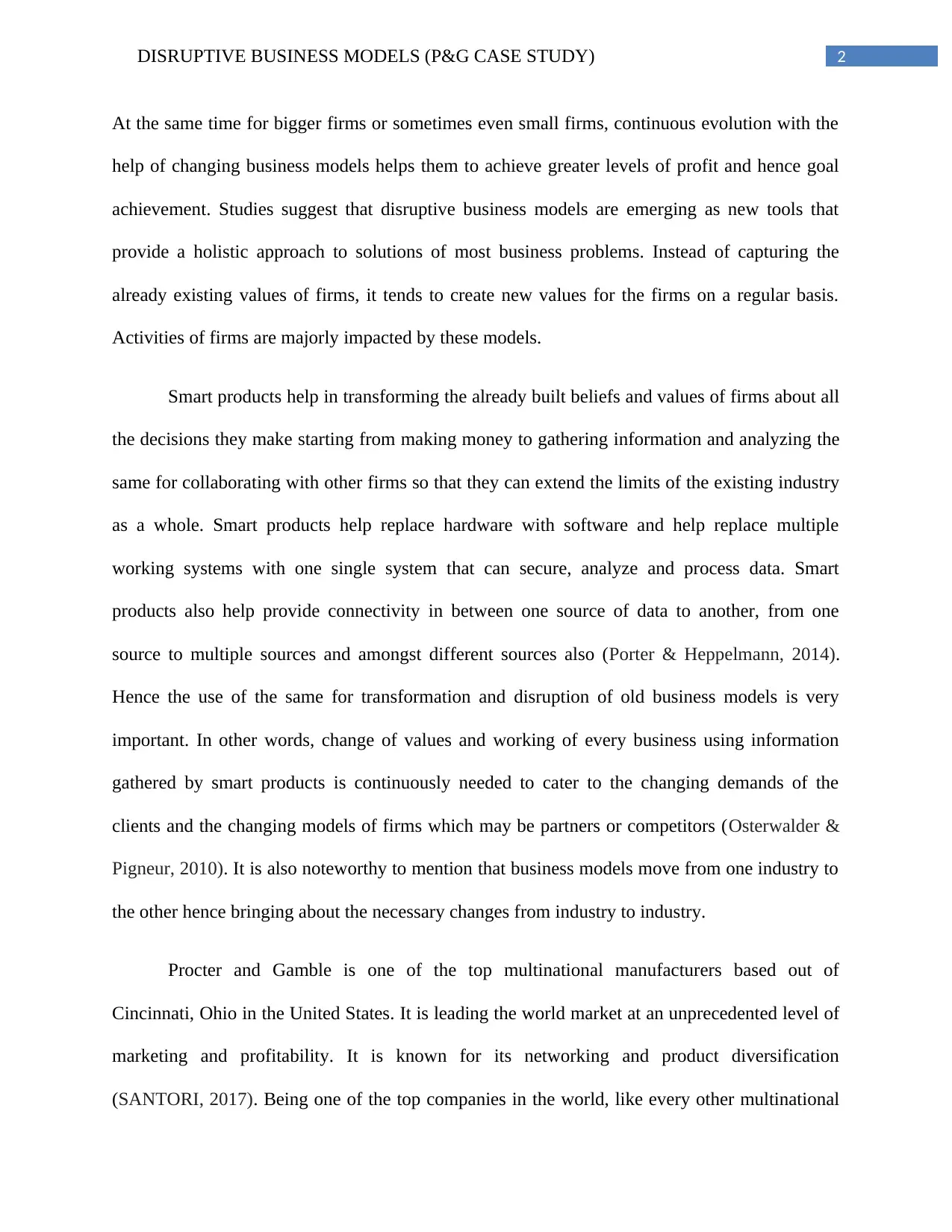
2DISRUPTIVE BUSINESS MODELS (P&G CASE STUDY)
At the same time for bigger firms or sometimes even small firms, continuous evolution with the
help of changing business models helps them to achieve greater levels of profit and hence goal
achievement. Studies suggest that disruptive business models are emerging as new tools that
provide a holistic approach to solutions of most business problems. Instead of capturing the
already existing values of firms, it tends to create new values for the firms on a regular basis.
Activities of firms are majorly impacted by these models.
Smart products help in transforming the already built beliefs and values of firms about all
the decisions they make starting from making money to gathering information and analyzing the
same for collaborating with other firms so that they can extend the limits of the existing industry
as a whole. Smart products help replace hardware with software and help replace multiple
working systems with one single system that can secure, analyze and process data. Smart
products also help provide connectivity in between one source of data to another, from one
source to multiple sources and amongst different sources also (Porter & Heppelmann, 2014).
Hence the use of the same for transformation and disruption of old business models is very
important. In other words, change of values and working of every business using information
gathered by smart products is continuously needed to cater to the changing demands of the
clients and the changing models of firms which may be partners or competitors (Osterwalder &
Pigneur, 2010). It is also noteworthy to mention that business models move from one industry to
the other hence bringing about the necessary changes from industry to industry.
Procter and Gamble is one of the top multinational manufacturers based out of
Cincinnati, Ohio in the United States. It is leading the world market at an unprecedented level of
marketing and profitability. It is known for its networking and product diversification
(SANTORI, 2017). Being one of the top companies in the world, like every other multinational
At the same time for bigger firms or sometimes even small firms, continuous evolution with the
help of changing business models helps them to achieve greater levels of profit and hence goal
achievement. Studies suggest that disruptive business models are emerging as new tools that
provide a holistic approach to solutions of most business problems. Instead of capturing the
already existing values of firms, it tends to create new values for the firms on a regular basis.
Activities of firms are majorly impacted by these models.
Smart products help in transforming the already built beliefs and values of firms about all
the decisions they make starting from making money to gathering information and analyzing the
same for collaborating with other firms so that they can extend the limits of the existing industry
as a whole. Smart products help replace hardware with software and help replace multiple
working systems with one single system that can secure, analyze and process data. Smart
products also help provide connectivity in between one source of data to another, from one
source to multiple sources and amongst different sources also (Porter & Heppelmann, 2014).
Hence the use of the same for transformation and disruption of old business models is very
important. In other words, change of values and working of every business using information
gathered by smart products is continuously needed to cater to the changing demands of the
clients and the changing models of firms which may be partners or competitors (Osterwalder &
Pigneur, 2010). It is also noteworthy to mention that business models move from one industry to
the other hence bringing about the necessary changes from industry to industry.
Procter and Gamble is one of the top multinational manufacturers based out of
Cincinnati, Ohio in the United States. It is leading the world market at an unprecedented level of
marketing and profitability. It is known for its networking and product diversification
(SANTORI, 2017). Being one of the top companies in the world, like every other multinational
⊘ This is a preview!⊘
Do you want full access?
Subscribe today to unlock all pages.

Trusted by 1+ million students worldwide
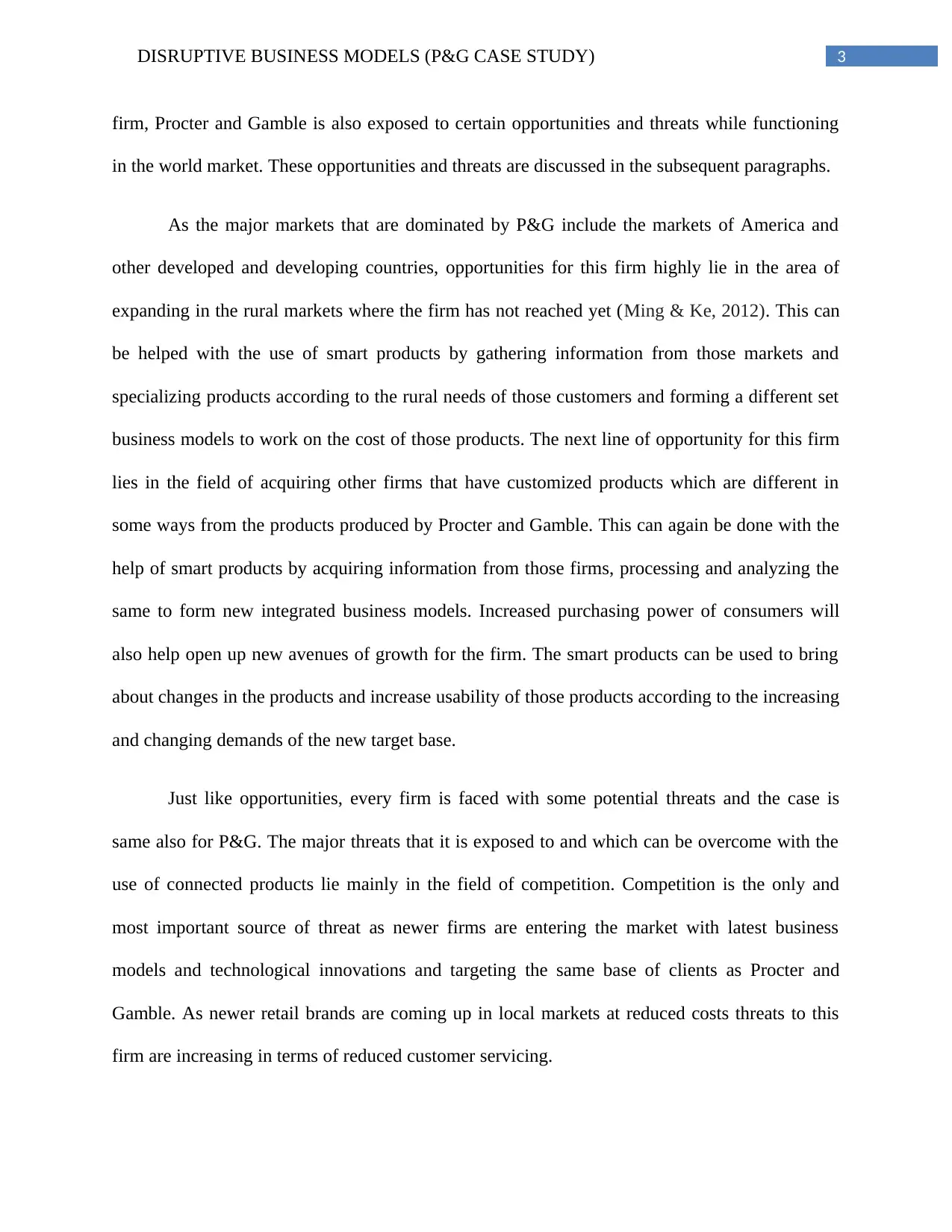
3DISRUPTIVE BUSINESS MODELS (P&G CASE STUDY)
firm, Procter and Gamble is also exposed to certain opportunities and threats while functioning
in the world market. These opportunities and threats are discussed in the subsequent paragraphs.
As the major markets that are dominated by P&G include the markets of America and
other developed and developing countries, opportunities for this firm highly lie in the area of
expanding in the rural markets where the firm has not reached yet (Ming & Ke, 2012). This can
be helped with the use of smart products by gathering information from those markets and
specializing products according to the rural needs of those customers and forming a different set
business models to work on the cost of those products. The next line of opportunity for this firm
lies in the field of acquiring other firms that have customized products which are different in
some ways from the products produced by Procter and Gamble. This can again be done with the
help of smart products by acquiring information from those firms, processing and analyzing the
same to form new integrated business models. Increased purchasing power of consumers will
also help open up new avenues of growth for the firm. The smart products can be used to bring
about changes in the products and increase usability of those products according to the increasing
and changing demands of the new target base.
Just like opportunities, every firm is faced with some potential threats and the case is
same also for P&G. The major threats that it is exposed to and which can be overcome with the
use of connected products lie mainly in the field of competition. Competition is the only and
most important source of threat as newer firms are entering the market with latest business
models and technological innovations and targeting the same base of clients as Procter and
Gamble. As newer retail brands are coming up in local markets at reduced costs threats to this
firm are increasing in terms of reduced customer servicing.
firm, Procter and Gamble is also exposed to certain opportunities and threats while functioning
in the world market. These opportunities and threats are discussed in the subsequent paragraphs.
As the major markets that are dominated by P&G include the markets of America and
other developed and developing countries, opportunities for this firm highly lie in the area of
expanding in the rural markets where the firm has not reached yet (Ming & Ke, 2012). This can
be helped with the use of smart products by gathering information from those markets and
specializing products according to the rural needs of those customers and forming a different set
business models to work on the cost of those products. The next line of opportunity for this firm
lies in the field of acquiring other firms that have customized products which are different in
some ways from the products produced by Procter and Gamble. This can again be done with the
help of smart products by acquiring information from those firms, processing and analyzing the
same to form new integrated business models. Increased purchasing power of consumers will
also help open up new avenues of growth for the firm. The smart products can be used to bring
about changes in the products and increase usability of those products according to the increasing
and changing demands of the new target base.
Just like opportunities, every firm is faced with some potential threats and the case is
same also for P&G. The major threats that it is exposed to and which can be overcome with the
use of connected products lie mainly in the field of competition. Competition is the only and
most important source of threat as newer firms are entering the market with latest business
models and technological innovations and targeting the same base of clients as Procter and
Gamble. As newer retail brands are coming up in local markets at reduced costs threats to this
firm are increasing in terms of reduced customer servicing.
Paraphrase This Document
Need a fresh take? Get an instant paraphrase of this document with our AI Paraphraser
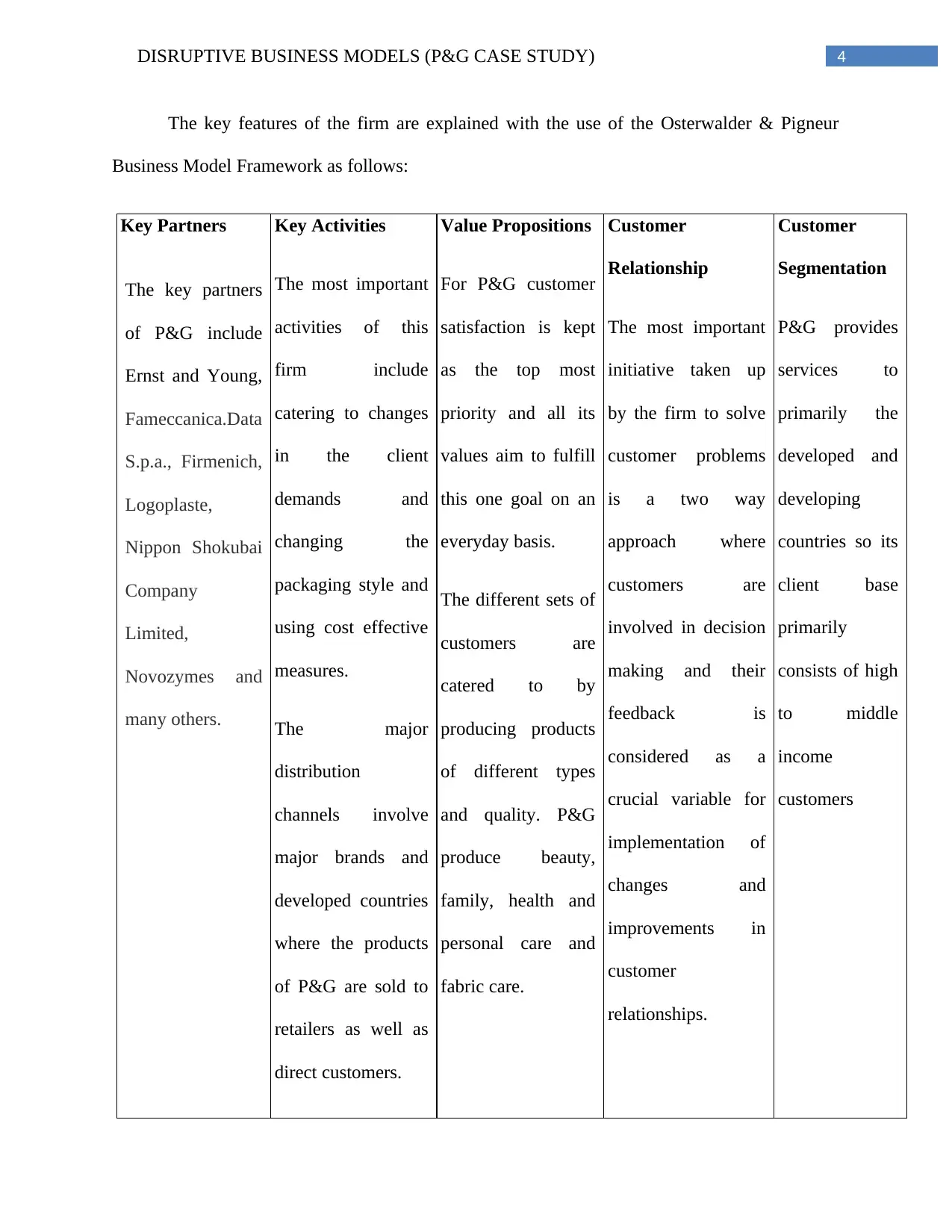
4DISRUPTIVE BUSINESS MODELS (P&G CASE STUDY)
The key features of the firm are explained with the use of the Osterwalder & Pigneur
Business Model Framework as follows:
Key Partners
The key partners
of P&G include
Ernst and Young,
Fameccanica.Data
S.p.a., Firmenich,
Logoplaste,
Nippon Shokubai
Company
Limited,
Novozymes and
many others.
Key Activities
The most important
activities of this
firm include
catering to changes
in the client
demands and
changing the
packaging style and
using cost effective
measures.
The major
distribution
channels involve
major brands and
developed countries
where the products
of P&G are sold to
retailers as well as
direct customers.
Value Propositions
For P&G customer
satisfaction is kept
as the top most
priority and all its
values aim to fulfill
this one goal on an
everyday basis.
The different sets of
customers are
catered to by
producing products
of different types
and quality. P&G
produce beauty,
family, health and
personal care and
fabric care.
Customer
Relationship
The most important
initiative taken up
by the firm to solve
customer problems
is a two way
approach where
customers are
involved in decision
making and their
feedback is
considered as a
crucial variable for
implementation of
changes and
improvements in
customer
relationships.
Customer
Segmentation
P&G provides
services to
primarily the
developed and
developing
countries so its
client base
primarily
consists of high
to middle
income
customers
The key features of the firm are explained with the use of the Osterwalder & Pigneur
Business Model Framework as follows:
Key Partners
The key partners
of P&G include
Ernst and Young,
Fameccanica.Data
S.p.a., Firmenich,
Logoplaste,
Nippon Shokubai
Company
Limited,
Novozymes and
many others.
Key Activities
The most important
activities of this
firm include
catering to changes
in the client
demands and
changing the
packaging style and
using cost effective
measures.
The major
distribution
channels involve
major brands and
developed countries
where the products
of P&G are sold to
retailers as well as
direct customers.
Value Propositions
For P&G customer
satisfaction is kept
as the top most
priority and all its
values aim to fulfill
this one goal on an
everyday basis.
The different sets of
customers are
catered to by
producing products
of different types
and quality. P&G
produce beauty,
family, health and
personal care and
fabric care.
Customer
Relationship
The most important
initiative taken up
by the firm to solve
customer problems
is a two way
approach where
customers are
involved in decision
making and their
feedback is
considered as a
crucial variable for
implementation of
changes and
improvements in
customer
relationships.
Customer
Segmentation
P&G provides
services to
primarily the
developed and
developing
countries so its
client base
primarily
consists of high
to middle
income
customers
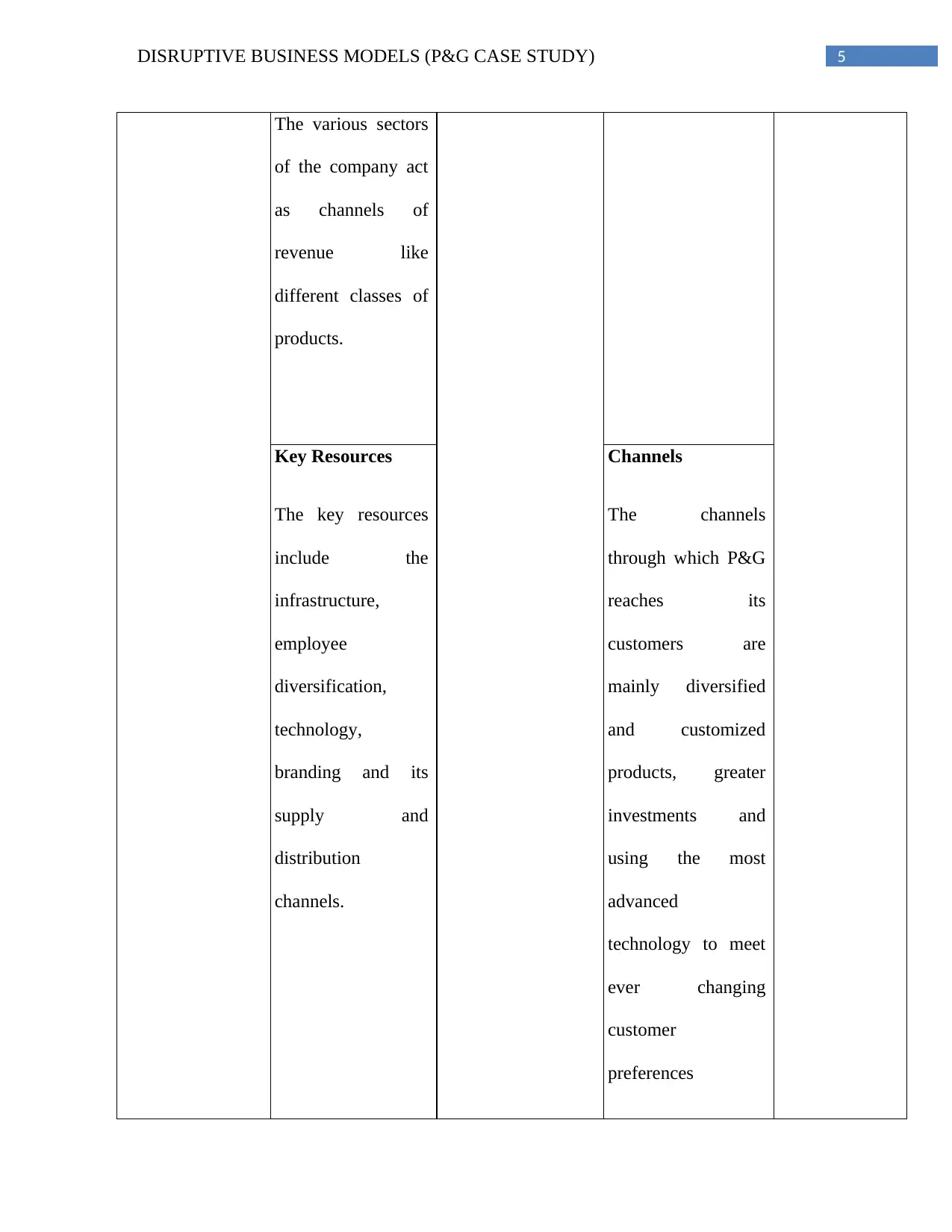
5DISRUPTIVE BUSINESS MODELS (P&G CASE STUDY)
The various sectors
of the company act
as channels of
revenue like
different classes of
products.
Key Resources
The key resources
include the
infrastructure,
employee
diversification,
technology,
branding and its
supply and
distribution
channels.
Channels
The channels
through which P&G
reaches its
customers are
mainly diversified
and customized
products, greater
investments and
using the most
advanced
technology to meet
ever changing
customer
preferences
The various sectors
of the company act
as channels of
revenue like
different classes of
products.
Key Resources
The key resources
include the
infrastructure,
employee
diversification,
technology,
branding and its
supply and
distribution
channels.
Channels
The channels
through which P&G
reaches its
customers are
mainly diversified
and customized
products, greater
investments and
using the most
advanced
technology to meet
ever changing
customer
preferences
⊘ This is a preview!⊘
Do you want full access?
Subscribe today to unlock all pages.

Trusted by 1+ million students worldwide
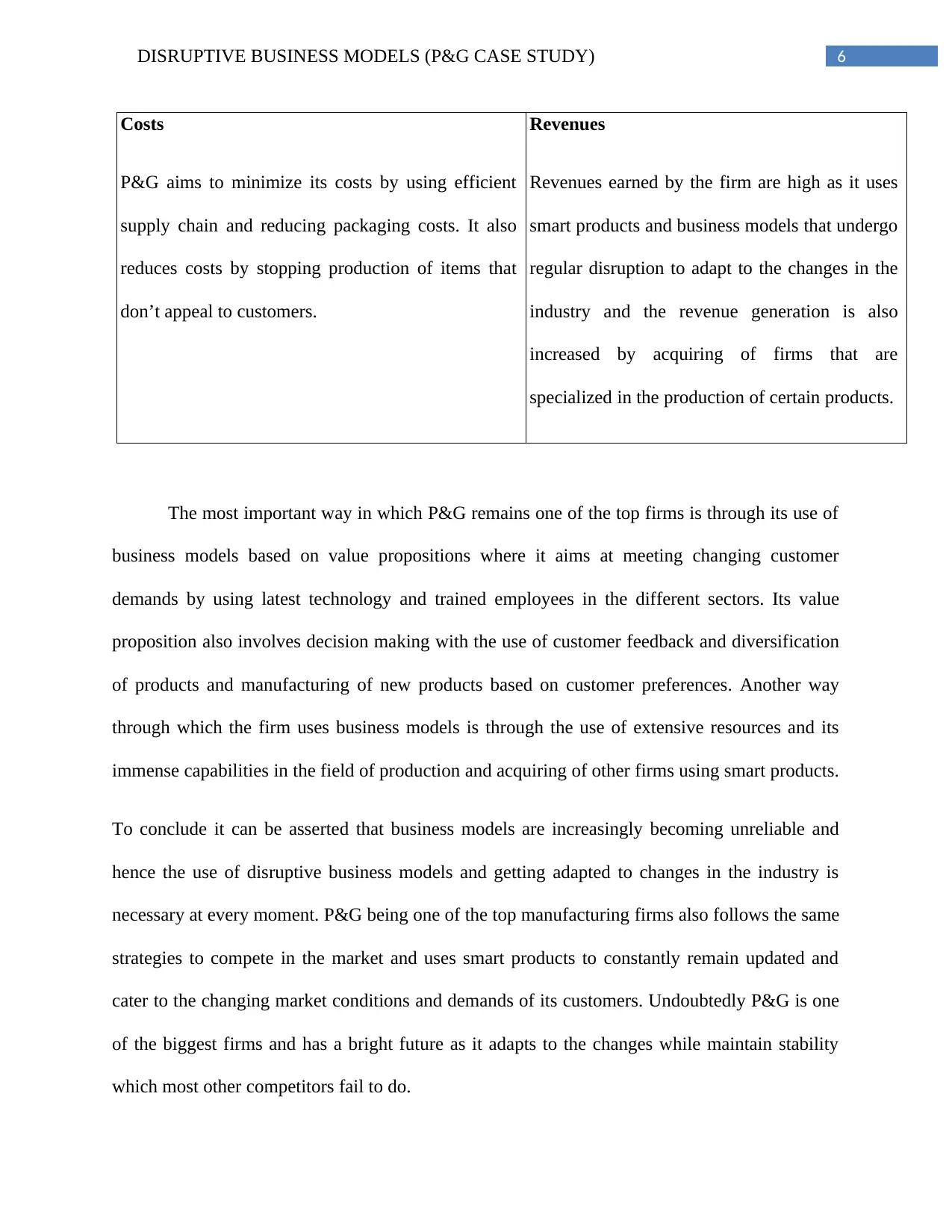
6DISRUPTIVE BUSINESS MODELS (P&G CASE STUDY)
Costs
P&G aims to minimize its costs by using efficient
supply chain and reducing packaging costs. It also
reduces costs by stopping production of items that
don’t appeal to customers.
Revenues
Revenues earned by the firm are high as it uses
smart products and business models that undergo
regular disruption to adapt to the changes in the
industry and the revenue generation is also
increased by acquiring of firms that are
specialized in the production of certain products.
The most important way in which P&G remains one of the top firms is through its use of
business models based on value propositions where it aims at meeting changing customer
demands by using latest technology and trained employees in the different sectors. Its value
proposition also involves decision making with the use of customer feedback and diversification
of products and manufacturing of new products based on customer preferences. Another way
through which the firm uses business models is through the use of extensive resources and its
immense capabilities in the field of production and acquiring of other firms using smart products.
To conclude it can be asserted that business models are increasingly becoming unreliable and
hence the use of disruptive business models and getting adapted to changes in the industry is
necessary at every moment. P&G being one of the top manufacturing firms also follows the same
strategies to compete in the market and uses smart products to constantly remain updated and
cater to the changing market conditions and demands of its customers. Undoubtedly P&G is one
of the biggest firms and has a bright future as it adapts to the changes while maintain stability
which most other competitors fail to do.
Costs
P&G aims to minimize its costs by using efficient
supply chain and reducing packaging costs. It also
reduces costs by stopping production of items that
don’t appeal to customers.
Revenues
Revenues earned by the firm are high as it uses
smart products and business models that undergo
regular disruption to adapt to the changes in the
industry and the revenue generation is also
increased by acquiring of firms that are
specialized in the production of certain products.
The most important way in which P&G remains one of the top firms is through its use of
business models based on value propositions where it aims at meeting changing customer
demands by using latest technology and trained employees in the different sectors. Its value
proposition also involves decision making with the use of customer feedback and diversification
of products and manufacturing of new products based on customer preferences. Another way
through which the firm uses business models is through the use of extensive resources and its
immense capabilities in the field of production and acquiring of other firms using smart products.
To conclude it can be asserted that business models are increasingly becoming unreliable and
hence the use of disruptive business models and getting adapted to changes in the industry is
necessary at every moment. P&G being one of the top manufacturing firms also follows the same
strategies to compete in the market and uses smart products to constantly remain updated and
cater to the changing market conditions and demands of its customers. Undoubtedly P&G is one
of the biggest firms and has a bright future as it adapts to the changes while maintain stability
which most other competitors fail to do.
Paraphrase This Document
Need a fresh take? Get an instant paraphrase of this document with our AI Paraphraser

7DISRUPTIVE BUSINESS MODELS (P&G CASE STUDY)
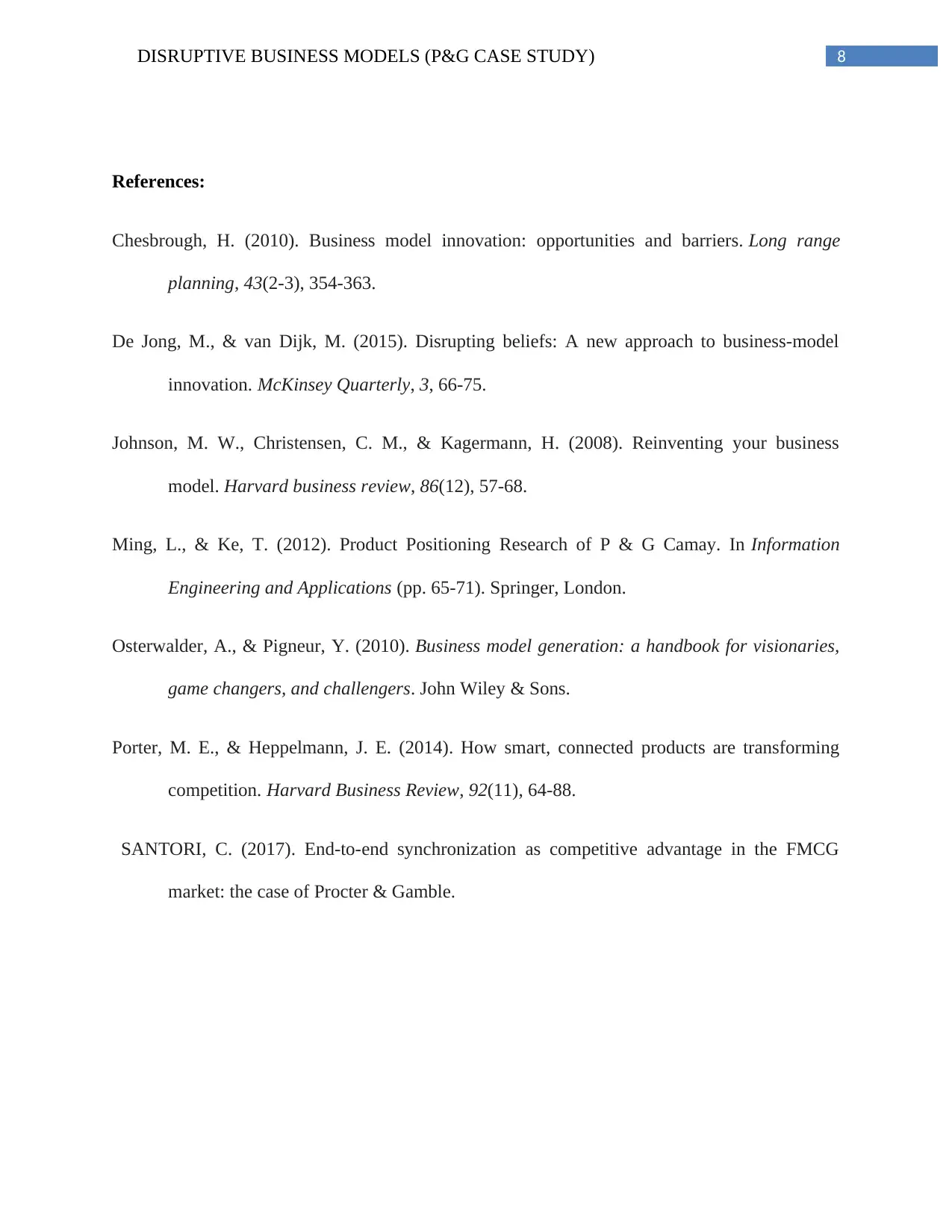
8DISRUPTIVE BUSINESS MODELS (P&G CASE STUDY)
References:
Chesbrough, H. (2010). Business model innovation: opportunities and barriers. Long range
planning, 43(2-3), 354-363.
De Jong, M., & van Dijk, M. (2015). Disrupting beliefs: A new approach to business-model
innovation. McKinsey Quarterly, 3, 66-75.
Johnson, M. W., Christensen, C. M., & Kagermann, H. (2008). Reinventing your business
model. Harvard business review, 86(12), 57-68.
Ming, L., & Ke, T. (2012). Product Positioning Research of P & G Camay. In Information
Engineering and Applications (pp. 65-71). Springer, London.
Osterwalder, A., & Pigneur, Y. (2010). Business model generation: a handbook for visionaries,
game changers, and challengers. John Wiley & Sons.
Porter, M. E., & Heppelmann, J. E. (2014). How smart, connected products are transforming
competition. Harvard Business Review, 92(11), 64-88.
SANTORI, C. (2017). End-to-end synchronization as competitive advantage in the FMCG
market: the case of Procter & Gamble.
References:
Chesbrough, H. (2010). Business model innovation: opportunities and barriers. Long range
planning, 43(2-3), 354-363.
De Jong, M., & van Dijk, M. (2015). Disrupting beliefs: A new approach to business-model
innovation. McKinsey Quarterly, 3, 66-75.
Johnson, M. W., Christensen, C. M., & Kagermann, H. (2008). Reinventing your business
model. Harvard business review, 86(12), 57-68.
Ming, L., & Ke, T. (2012). Product Positioning Research of P & G Camay. In Information
Engineering and Applications (pp. 65-71). Springer, London.
Osterwalder, A., & Pigneur, Y. (2010). Business model generation: a handbook for visionaries,
game changers, and challengers. John Wiley & Sons.
Porter, M. E., & Heppelmann, J. E. (2014). How smart, connected products are transforming
competition. Harvard Business Review, 92(11), 64-88.
SANTORI, C. (2017). End-to-end synchronization as competitive advantage in the FMCG
market: the case of Procter & Gamble.
⊘ This is a preview!⊘
Do you want full access?
Subscribe today to unlock all pages.

Trusted by 1+ million students worldwide
1 out of 9
Related Documents
Your All-in-One AI-Powered Toolkit for Academic Success.
+13062052269
info@desklib.com
Available 24*7 on WhatsApp / Email
![[object Object]](/_next/static/media/star-bottom.7253800d.svg)
Unlock your academic potential
Copyright © 2020–2025 A2Z Services. All Rights Reserved. Developed and managed by ZUCOL.




